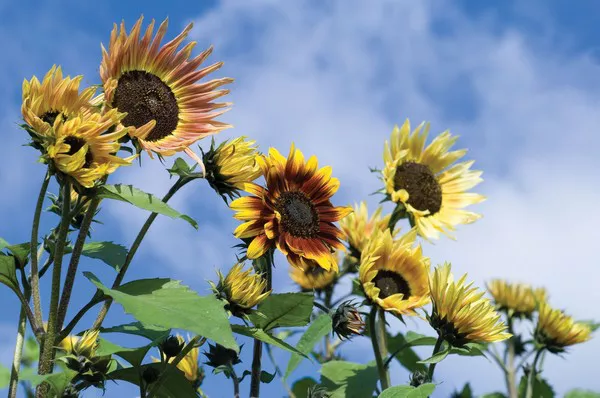Sunflowers, with their vibrant blooms and towering stems, are a delightful addition to gardens, bringing a touch of sunshine to any landscape. However, the joy of cultivating sunflowers can be marred when something starts devouring their leaves. The mystery of what keeps eating sunflower leaves can be perplexing for gardeners, but understanding the potential culprits and implementing effective strategies for protection is crucial. In this comprehensive guide, we will explore the common pests and other factors that may be responsible for the damage to sunflower leaves, empowering gardeners to preserve the beauty and health of their sunflowers.
Identifying Common Pests Targeting Sunflower Leaves
One of the primary suspects when it comes to what keeps eating sunflower leaves is a variety of pests that find these plants particularly appealing. Aphids, for instance, are tiny, sap-sucking insects that can quickly multiply and cause damage to sunflower leaves. These pests not only consume the plant’s sap but also excrete a substance known as honeydew, which attracts other pests and promotes the growth of sooty mold.
Caterpillars, including the larvae of butterflies and moths, are notorious for their leaf-chomping habits. The larvae of species like the painted lady butterfly and the sunflower moth can feast on sunflower leaves, causing visible damage. Slugs and snails are other culprits, leaving behind distinctive trails of slime as they graze on the tender foliage.
Rodents and Larger Wildlife
While insects are often the primary suspects, larger creatures can also be responsible for the mysterious disappearance of sunflower leaves. Rabbits, deer, and groundhogs are known to nibble on sunflowers, especially when other food sources are scarce. Fencing or protective barriers can be effective in deterring these larger animals and preserving the integrity of sunflower foliage.
Environmental Factors
Sometimes, what keeps eating sunflower leaves may not be a living organism but rather environmental factors. Sunflowers are resilient plants, but they can be susceptible to damage caused by adverse weather conditions. Wind, hail, heavy rain, and intense sunlight can all contribute to stress on the plants, leading to torn or withered leaves. Regularly inspecting sunflowers for signs of environmental stress is essential for differentiating between natural factors and pest-related damage.
See Also: What flower symbolizes blessings?
Diseases and Pathogens
In addition to pests and environmental factors, diseases and pathogens can also impact sunflower leaves. Fungal infections, such as powdery mildew and downy mildew, can manifest as white or gray powdery substances on the leaves, hindering photosynthesis and weakening the plant. Proper spacing, adequate air circulation, and preventive fungicide treatments can help manage and mitigate the impact of diseases on sunflower leaves.
Companion Planting Strategies
To deter pests and protect sunflower leaves, consider implementing companion planting strategies. Certain plants have natural repellent properties that can help shield sunflowers from potential threats. Marigolds, for example, emit a scent that repels many pests, making them excellent companions for sunflowers. Additionally, planting aromatic herbs like basil and oregano can help deter pests that might otherwise be attracted to sunflowers.
Beneficial Insects for Pest Control
Harnessing the power of beneficial insects is a sustainable and natural way to control pest populations that are feasting on sunflower leaves. Ladybugs, lacewings, and predatory beetles are among the beneficial insects that prey on aphids, caterpillars, and other pests. Creating an environment that attracts and supports these beneficial insects, such as by providing nectar-rich flowers and avoiding the use of broad-spectrum pesticides, can contribute to a healthier balance in the garden ecosystem.
Organic Pest Control Measures
For gardeners who prefer organic approaches to pest control, several methods can be effective in preventing what keeps eating sunflower leaves. Neem oil, derived from the neem tree, has insecticidal properties and can be used to deter pests like aphids and caterpillars. Additionally, insecticidal soaps made from natural ingredients can be sprayed on sunflower leaves to eliminate soft-bodied pests without harming beneficial insects.
Physical Barriers and Traps
Installing physical barriers and traps is another practical strategy to protect sunflower leaves from pests. Row covers, mesh netting, and floating row covers can be employed to shield sunflowers from insect infestations, especially during vulnerable growth stages. Additionally, sticky traps can help capture flying pests like aphids and whiteflies, reducing their numbers and minimizing the damage to sunflower leaves.
Regular Monitoring and Early Intervention
One of the most proactive measures in preventing what keeps eating sunflower leaves is regular monitoring of the plants. By routinely inspecting sunflowers for signs of pest infestations, diseases, or environmental stress, gardeners can intervene early and implement targeted solutions. Prompt removal of affected leaves, proper disposal of debris, and early treatment with organic or chemical remedies can prevent the escalation of problems and preserve the overall health of sunflowers.
Soil Health and Nutrient Management
Ensuring optimal soil health and nutrient levels is a fundamental aspect of promoting sunflower vigor and resilience against pests. Well-nourished plants are better equipped to withstand pest pressures and recover from environmental stress. Conducting soil tests, amending soil with organic matter, and providing balanced fertilization can contribute to the overall health of sunflowers, making them less susceptible to what keeps eating their leaves.
Conclusion
In the quest to uncover what keeps eating sunflower leaves, gardeners must consider a range of potential culprits, from common pests to environmental factors. By identifying the specific threats and implementing proactive strategies, such as companion planting, beneficial insect support, and organic pest control measures, gardeners can effectively protect their sunflowers. Regular monitoring, early intervention, and attention to soil health are key components of a holistic approach to sunflower care, ensuring that these vibrant blooms continue to bring joy to gardens while remaining resilient against potential threats.


